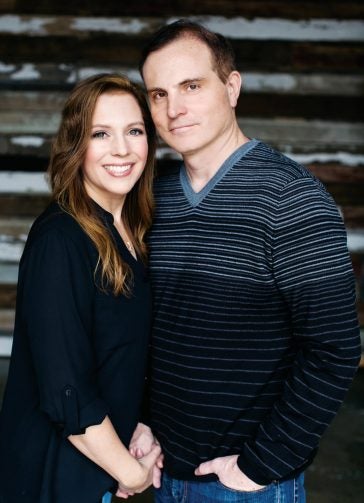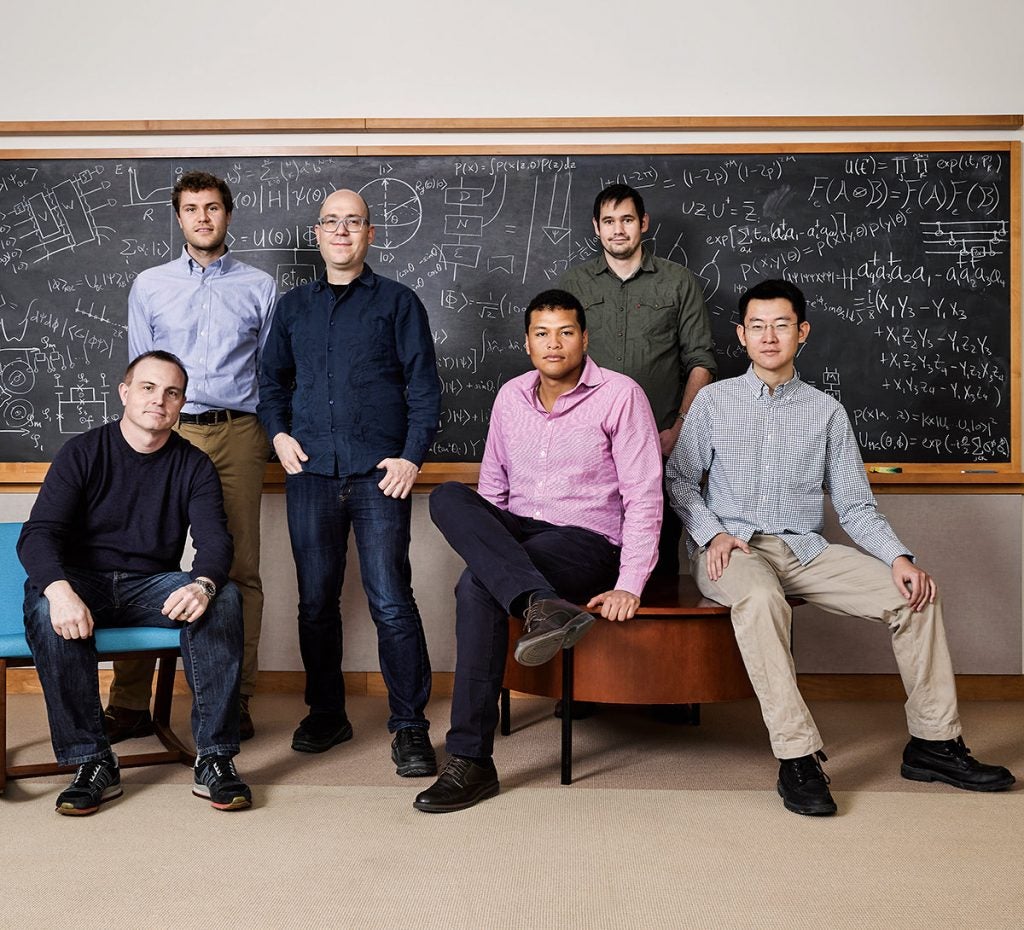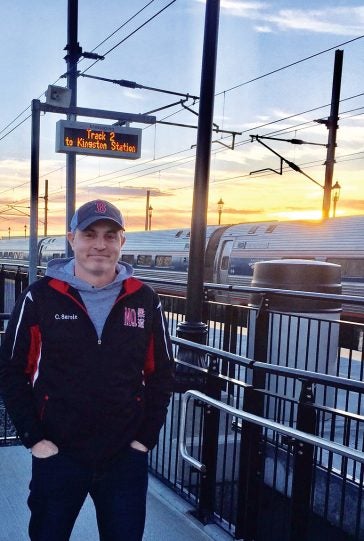Christopher Savoie ’92 has founded a string of cutting-edge, high-tech companies. He developed a natural language interface that became the basis for Siri. Now, he’s set his sights on revealing the deepest secrets of chemistry through quantum computing—and changing the world in the process.
A Revolution Begins
When Christopher Savoie was 7, he got a chemistry set for Christmas. A smart, inquisitive child, he set about mixing and matching compounds. He produced multicolored liquids, heated beakers over Bunsen burners, and took measurements of compounds’ pH levels. Then he set his mind to mischief. “What can I get away with?” he remembers thinking. One day, he sprinkled powdered potassium with water and set it ablaze. Boom—it exploded. It was pretty much the coolest thing he’d ever seen. Other highly combustible experiments followed, though thankfully he never did very much harm. “I survived,” he says. “I still have all my digits.”
Quantum computing could lead to 100 percent-efficient fuel cells, sweeping advances in drug discovery and personalized medicine, and possibly even a catalyst for removing pollution from the air.
In fact, Savoie did more than survive. Combining an extraordinary intellect (he earned an undergraduate degree in biology from URI in just three years, has a doctoral degree in molecular medicine, and also has a law degree) with uncanny business acumen, he’s founded a string of cutting-edge, high-tech companies. In the early 1990s, the fledgling days of the internet, he built a web design firm that made millions. Later, at the Japan-based Gene Networks International (GNI), Savoie pioneered the application of big data and bioinformatics to genetics in pursuit of new drugs. A few years ago, the world’s largest financial newspaper, Japan’s The Nikkei, cited Savoie as one of the nine most influential leaders in global biotechnology.

Now at the helm of Cambridge, Massachusetts-based Zapata Computing, he’s back to doing chemistry experiments. “I still get to play with toys,” he says, although these days, the toys are quantum computers, potentially the most powerful computers ever designed. Zapata uses quantum computers to model chemical reactions at the subatomic level. Far from causing mayhem or destruction, these “toys” could reveal the deepest secrets of chemistry and enable Zapata to create a new generation of materials and medicines. According to Savoie, quantum computing could lead to 100 percent-efficient fuel cells, sweeping advances in drug discovery and personalized medicine, and possibly even a catalyst for removing pollution from the air.
Savoie lives in Kingston, Rhode Island, with his wife, Amy Vican Savoie ’93, a patent attorney with a Ph.D. in immunology from Dartmouth Medical School. He commutes by train each day from Kingston to Cambridge, where his partner at Zapata is scientist Alán Aspuru-Guzik. Aspuru-Guzik named the company for Emiliano Zapata Salazar, leader of Mexico’s early 20th century peasant uprising. Savoie quickly grasped the significance of the name. If Zapata succeeds, he says, “It’s going to be a revolution.”
Brains and Blackboards
Zapata Computing’s Cambridge office doesn’t look like ground zero for a scientific revolution. Housed in The Engine, MIT’s startup incubator, it comprises a few small rooms filled with filing cabinets and tables pushed together to create makeshift workspaces. The 15 staffers scribble linear algebraic formulas on blackboards and pass around hand-drawn diagrams of computer circuitry on paper. They are a cutting-edge tech company, but they keep it old-school.

Zapata designs software for quantum computers, content to let the big players—Microsoft, Google, IBM, and others—design the hardware. Of course, you can’t program a quantum machine with HTML or Java. The programmers “have to have a new intuition, a different type of intuition,” says URI physics professor Leonard M. Kahn. Savoie says there are only a few dozen people in the whole world who have that kind of intuition. A good percentage of them trained with Aspuru-Guzik in his lab at Harvard, then made the move to Zapata.
Savoie met Aspuru-Guzik in 2016 at Harvard. Savoie was then CEO of the company Kyulux, which developed cutting-edge organic light-emitting diodes (OLEDs) used in computer and electronics displays. For seven years, the founding chemists at Kyulux worked in the lab on designing new molecules and materials for use in OLEDs. Aspuru-Guzik, who had no previous affiliation with Kyulux, came up with machine-learning algorithms that could discover equivalent materials in just six months. “I was like, ‘OK, touché, you beat us,’” Savoie recalls. “‘How can we work together?’”
As they talked over a burrito lunch, Savoie says he realized that Aspuru-Guzik was “an absolute genius.” Aspuru-Guzik was likewise impressed by Savoie’s extensive business experience and “bali bali,” a South Korean phrase describing the country’s “hurry hurry” work culture. “It means, ‘Quick—let’s get this done. No BS,’” says Aspuru-Guzik, now at the University of Toronto. “That’s Chris—friendly, affable, but also very bali bali. And I can only work with bali bali people.”
The hard-charging Aspuru-Guzik insisted that Savoie join him in starting Zapata. In fact, he was introducing Savoie as the CEO before Savoie had officially accepted the job.

To date, the company has raised $5.4 million in venture capital, a remarkably large sum in a short period of time for a startup in a nascent and unproven technology. Savoie says they are well on the road to profitability. He’s already inked partnership deals with IBM, Google, and Rigetti Computing in Berkeley, California.
Peter Carre, an Australia-based technology financier who invested in Savoie’s previous companies, says what investors want to know about a startup is, “Can these people actually execute their technology commercially, and can they do it with the amount of money they are given, in the time it has to be executed? A guy like Chris,” he says, “makes investors feel sure that the answer to those questions is, ‘Yes.’”
The Strange World of Quantum Mechanics

The idea for a quantum computer originated in 1982 in a lecture by Nobel Prizewinning scientist Richard Feynman. Reality at its most fundamental level, the level of subatomic particles, is governed by the very strange, counterintuitive laws of quantum mechanics (QM). Therefore, Feynman said, to understand reality, you need a computer that runs according to the laws of QM—to wit, a quantum computer.
Traditional computers interpret the world as 0s and 1s. Whatever the machine processes, from a sentence to a video stream, is translated into 0s and 1s. In computer-speak, URI is “01110101 01110010 01101001.” These 0s and 1s are stored on bits. Each bit can be only one of those two values.
Quantum computers use quantum bits, or qubits, which can be a 0 and a 1 simultaneously. This might sound impossible, but qubits obey the principles of QM. With QM, “what we anticipate from our intuition about how the world works is completely violated,” says URI physics professor Leonard Kahn. “What you think will be the answer to a problem isn’t necessarily anywhere close to what the real answer is.” Under the laws of QM, the location and energy level of an electron in orbit around an atomic nucleus can have many values at once. For reasons we don’t fully understand, when you take a measurement of energy level or location, the value becomes fixed and you get a single answer; but until then, there is a range of possible values. This state of indeterminacy is called superposition. Qubits can simultaneously have a value of 0 and 1 because they are in a state of superposition.
Quantum computers will enable us to model and understand chemical systems at a fundamental, subatomic level, where they will give up their secrets, enabling us to see vast new possibilities.
The difference in computing power between a bit and a qubit is stark. Sixty bits can hold 120 possible values, each either a 0 or a 1. Sixty qubits can hold more than a quintillion.
Much of Aspuru-Guzik’s research has focused on understanding chemical reactions. The subatomic particles in chemical elements follow the principles of QM, which is why quantum computers can be so useful in analyzing their behavior. Only a quantum computer, whose qubits can hold an exponentially large number of values, can handle the exponentially large values of the subatomic particles involved in chemical systems.
Using traditional computers in chemistry, Savoie says, leaves huge gaps in our knowledge. We can’t tell what’s happening at the subatomic level. We fill in the blanks with our best guesses. “Chemicals are inherently quantum things, yet we are using classical approximations of what they are,” he says. “Right now chemistry is still alchemy—trial and error.” Quantum computers, Savoie says, will enable us to model and understand chemical systems at a fundamental, subatomic level, where they will give up their secrets, enabling us to see vast new possibilities. “What quantum computing in chemistry will allow us to do is to authentically simulate the system,” Savoie says. “We will know exactly how materials are put together.”
From Scholar to Entrepreneur
Savoie was born in Warwick and grew up in North Kingstown, Rhode Island. His parents were both schoolteachers. His mother, Crystal Brown Savoie, was a 1965 URI graduate; she died when Savoie was an infant.
As a child, Savoie got his first computer around the time he got his chemistry set. He taught himself Logo, an early computer programming language for kids. When he arrived at URI, a graduate of Bishop Hendricken High School in Warwick, he’d already taken several AP science classes. As a result, “I got to take some very advanced classes at URI starting out,” Savoie says. “This allowed me to really stretch my mind.”
Marian Goldsmith, professor emerita of biology, accepted Savoie into her 500-level molecular biology class. “He aced it,” she says. “He loved solving problems and he thought outside the box.”
For his senior project, Savoie analyzed a data set from the federal government on what happens to kids who suffer childhood trauma. “It was my first crack at doing big data,” he says. He found that suffering emotional neglect and having alcoholic parents left a longer and more damaging impact on children than physical violence. “I wasn’t expecting that outcome,” he says.
Former URI sociologist Richard J. Gelles, who guided Savoie’s research, says, “Right away, you could tell Chris was really smart and highly motivated. The average undergraduate is not inclined to plunge into statistical analysis, but he was really good at it.”
The summer after his sophomore year at URI, Savoie interned at an immunology lab at Kyushu University in southern Japan. When he graduated from URI, he returned to Kyushu, enrolling in the molecular medicine Ph.D. program there. He intended to become a doctor, but—a hypochondriac with an aversion to blood—he thought better of it (though not before completing his medical degree). He also gravitated away from academia. “I was not happy doing medical research that would only become useful 20 or 30 years in the future,” he says.
A new platform called the internet was starting up around this time. Kyushu was installing what, by today’s standards, was a very rudimentary campus network. Savoie was asked to help with the implementation. He agreed, and in the process of programming the network, learned the web’s lingua franca, HTML.
People began asking him to design their websites, and Savoie realized this could become a side business. He called his company Atmark, and it soon became much more than a side gig, raising $8 million from investors. “It grew and grew,” Savoie says. Atmark designed the first-ever website for a Japanese professional baseball team—not a coincidence, as Savoie is a huge fan of the sport. It broadcast live scores from the stadium via a 14,400-bits-per-second modem.
Savoie also served as Atmark’s pitchman. He traveled around Japan by bullet train, returning in the afternoon or evening to work on his Ph.D. “I would race back to Kyushu, change out of my suit, and put on my lab coat,” says Savoie. “It was an interesting double life for a while.”
Then, one night at a dinner party in 1997, Savoie complained to his friend, Babak Hodjat, about how hard it was to program a VCR. He thought there should be a way to give the machine voice commands in natural language. He wanted to be able to say, “Can you record all the baseball games on TV over the next month?” and have the VCR do it.
Savoie began working on a computer program utilizing artificial intelligence to achieve this. Hodjat, skeptical at first, joined the effort. Eventually, they built a system for talking into a microphone connected to a computer. The computer parsed the instructions and relayed them to the VCR. “We basically had Amazon Echo working in our living room by 1998,” Savoie says.
They called their company Dejima, after the Dutch trading post in Nagasaki Bay that linked Japan and the rest of the world in the 17th and 18th centuries. Dejima was eventually sold to software company Sybase, now part of the German conglomerate SAP. But the natural language user interface Savoie and Hodjat developed eventually found its way to Apple, where it became the basis for Siri.
Clearing the Entanglement Hurdle

Last year, a report from the National Academy of Sciences (NAS) cast doubt on the possibility of creating a fault-tolerant quantum computer—one that remains operational even if one of its components fails or encounters an error. Significant technical hurdles remain, the report said. URI’s Kahn agrees with the report’s conclusion that it may be at least a decade before we see a completely fault-tolerant quantum computer that can live up to the technology’s full promise and potential. “This is something that’s been on the threshold for at least a couple of decades,” he says. “With all the resources and the great minds that have been working on this, we’ve made some progress, but we’re very far away from having something that’s workable.”
The difficulties stem, in part, from a feature of QM called entanglement. When two particles are entangled, they exert a mysterious influence over each other. To understand this, picture two spinning coins. If the coins behaved like entangled particles, the way one coin landed would determine how the other coin would land. In other words, if one landed on heads, that would cause the other to land on heads, too. If one landed on tails, so would the other.
So, with entangled particles, when you measure one, the second will have the same value. It’s as if the particles are somehow in communication with each other, the first telling the other what to do. In theory, entanglement can stretch over vast distances, even in cases where the particles are on opposite sides of the universe. Einstein called this phenomenon “spooky action at a distance.”
Qubits also become entangled. This offers a huge advantage because you need less computing power to manipulate the qubits. A change in one instantly transforms the other. “You can do multiple things at once,” Kahn says. “It’s much more efficient than having to deal with traditional bits one at a time.” But entanglement is a very transitory state, lasting milliseconds. And when qubits fall out of entanglement into what’s called decoherence, they no longer possess the special properties that make them so powerful inside a quantum computer.
Designers of quantum computers need to go to extreme lengths to ensure entangled qubits stick around long enough to carry out the desired calculations. “It’s a technologically daunting problem,” says Kahn. IBM’s solution is to lock the qubits into an entangled state by freezing them. Its quantum computer is chilled to almost -459.67 degrees Fahrenheit, almost absolute zero. This is one reason you shouldn’t expect to see a quantum computer in your home or in your iPhone any time soon.
Quantum computers also need to be heavily shielded from the outside environment. Stray heat, electromagnetic noise, or vibration can disrupt a qubit’s functioning and cause the loss of data. It’s no easy feat to build a quantum computer’s contaminant-free container.
Savoie points out that if Zapata’s software can shave even three-quarters of a percent off a Fortune 500 company’s supply chain or sales expenses, it would result in tens—if not hundreds—of millions of dollars in savings.
But the NAS report talked about another type of quantum computer that’s easier to build, known as Noisy Intermediate-Scale Quantum (NISQ) technology. A fault-tolerant quantum computer will need millions of qubits to reach its full potential. NISQ-era quantum computers only require between 50 and a few hundred. NISQ machines already exist, built by IBM, Google, Microsoft, and others. The most powerful one to date runs on 79 qubits. Zapata’s software is designed to run on the NISQ platform. Even if the full error-corrected quantum revolution isn’t here yet, the company can still be profitable and the solutions will still far exceed what traditional computers are capable of.
And Zapata is seeking business opportunities beyond chemistry. It’s looking to sell its algorithms to Wall Street investors. Quantum computers excel at calculating probabilities with an exponentially high number of outcomes, making them ideal for predicting market fluctuations.
They may also be ideal for tackling the so-called traveling salesman problem, which is a classic mathematics conundrum with real-world financial implications. Suppose your business is sending a salesperson on a multi-city trip. You want her to take the shortest route. This is fairly easy to figure out if the trip involves only a small number of stops. You calculate the distances of all the alternate routes and choose the shortest.
But what if the trip involves 15 cities? Then there are 87 billion possible routes. And if you have to coordinate the routes for numerous salespeople? Or the shortest route and the cheapest airfares? Even a supercomputer will soon find itself overwhelmed. But a NISQ quantum computer could be very useful.
As Savoie points out, if Zapata’s software can shave even three-quarters of a percent off a Fortune 500 company’s supply chain or sales expenses, it would result in tens—if not hundreds—of millions of dollars in savings. Savoie thinks Zapata could become a major player in business logistics.
The Next Challenge
Lately, Savoie has been thinking about another opportunity—curbing global warming with RuBisCo. It’s an enzyme involved in photosynthesis that enables plants to draw carbon dioxide out of the atmosphere. The molecular structure and chemical makeup of a RuBisCo molecule are well-known, but we still don’t know how it works at the subatomic level.
Zapata’s algorithms could potentially reveal this, Savoie says. We might be able to harness the power of RuBisCo to remove carbon dioxide from our atmosphere to combat global warming. The field of chemistry “is about to change, because we will know exactly what the system is doing on a quantum level,” Savoie says. “It’s going to be groundbreaking.”
Photos: Tony Luong; istockphoto.com; Doug Levy for the Engine; Amy Savoie

Fascinating article! These visionaries and people like them will make science fiction a reality and create for our children, grandchildren, etc. … a promising future. I urge the naysayers of some of today’s future-thinking politicians and policies to take note.
PS. You should have buttons so that magazine articles can be “shared.”
Thanks for your comment Gary.
And we’re working on getting a share button working. In the meantime, please feel free to copy and share the link.
Great to hear from you.